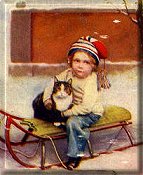During the
Trip
Whether going by land or air, your cat is safe in the carrier.  In the plane, it is most likely with you in the cabinet under the seat.
Most airlines allow small pets in cabin and this is much safer for them
than being in the hold. Your pet's travel bag contains everything
you need for the trip. Do not tranquilize your pet. Tranquilizers
change the way the body reacts to stress and to temperature changes potentially
putting your pet at risk.
In the plane, it is most likely with you in the cabinet under the seat.
Most airlines allow small pets in cabin and this is much safer for them
than being in the hold. Your pet's travel bag contains everything
you need for the trip. Do not tranquilize your pet. Tranquilizers
change the way the body reacts to stress and to temperature changes potentially
putting your pet at risk.
If your pet has an accident, stop as soon as you can, move into the
back seat with the cat making sure all doors are closed and locked.
Now take your pet out and see if they need cleaning up first. If
so,  use a
wipe them with a paper towel to remove as much as possible. (If your
cat is a terrible mess, you might want to do this with a diaper on your
lap so you don't get messy.) Then dampen a paper towel with spring
water and wash the dirty areas. Wipe dry with another paper towel.
At this point, you can let your pet loose (or ask your traveling companion
to hold your pet) while you turn your attention to the carrier. You can
clean up the worst of the mess in the carrier with the diaper and put it
in the garbage bag. Spray the carrier with the disinfectant and then
wipe it clean with the paper towels. Reline the carrier with a fresh
diaper. Replace your cat in the carrier.
use a
wipe them with a paper towel to remove as much as possible. (If your
cat is a terrible mess, you might want to do this with a diaper on your
lap so you don't get messy.) Then dampen a paper towel with spring
water and wash the dirty areas. Wipe dry with another paper towel.
At this point, you can let your pet loose (or ask your traveling companion
to hold your pet) while you turn your attention to the carrier. You can
clean up the worst of the mess in the carrier with the diaper and put it
in the garbage bag. Spray the carrier with the disinfectant and then
wipe it clean with the paper towels. Reline the carrier with a fresh
diaper. Replace your cat in the carrier.
If your cat's accident is due to diarrhea, give it a dose of the diarrhea
medication prescribed by your vet to help prevent other accidents.
If your cat is vomiting, give your cat a dose of the nausea medication
your vet prescribed to settle its stomach.
Most cats settle down and sleep for most of the trip although they may
cry for the first little while. A good idea is to take your cat on
several short local trips to get it used to being in the car. Cats
that only go in the car to go to the vet are often reluctant travelers
since the trip does not have good associations for them!
 In the plane, it is most likely with you in the cabinet under the seat.
Most airlines allow small pets in cabin and this is much safer for them
than being in the hold. Your pet's travel bag contains everything
you need for the trip. Do not tranquilize your pet. Tranquilizers
change the way the body reacts to stress and to temperature changes potentially
putting your pet at risk.
In the plane, it is most likely with you in the cabinet under the seat.
Most airlines allow small pets in cabin and this is much safer for them
than being in the hold. Your pet's travel bag contains everything
you need for the trip. Do not tranquilize your pet. Tranquilizers
change the way the body reacts to stress and to temperature changes potentially
putting your pet at risk.
 use a
wipe them with a paper towel to remove as much as possible. (If your
cat is a terrible mess, you might want to do this with a diaper on your
lap so you don't get messy.) Then dampen a paper towel with spring
water and wash the dirty areas. Wipe dry with another paper towel.
At this point, you can let your pet loose (or ask your traveling companion
to hold your pet) while you turn your attention to the carrier. You can
clean up the worst of the mess in the carrier with the diaper and put it
in the garbage bag. Spray the carrier with the disinfectant and then
wipe it clean with the paper towels. Reline the carrier with a fresh
diaper. Replace your cat in the carrier.
use a
wipe them with a paper towel to remove as much as possible. (If your
cat is a terrible mess, you might want to do this with a diaper on your
lap so you don't get messy.) Then dampen a paper towel with spring
water and wash the dirty areas. Wipe dry with another paper towel.
At this point, you can let your pet loose (or ask your traveling companion
to hold your pet) while you turn your attention to the carrier. You can
clean up the worst of the mess in the carrier with the diaper and put it
in the garbage bag. Spray the carrier with the disinfectant and then
wipe it clean with the paper towels. Reline the carrier with a fresh
diaper. Replace your cat in the carrier.